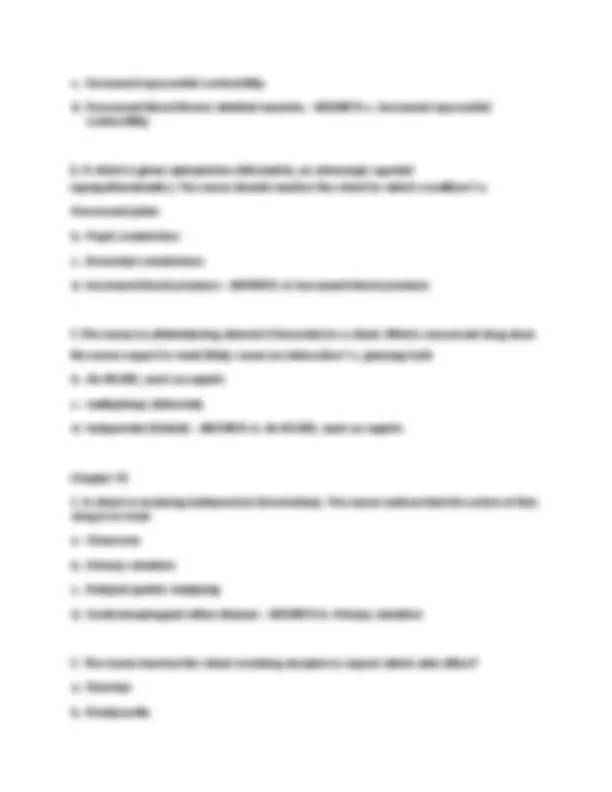






























































































Study with the several resources on Docsity

Earn points by helping other students or get them with a premium plan


Prepare for your exams
Study with the several resources on Docsity

Earn points to download
Earn points by helping other students or get them with a premium plan
Community
Ask the community for help and clear up your study doubts
Discover the best universities in your country according to Docsity users
Free resources
Download our free guides on studying techniques, anxiety management strategies, and thesis advice from Docsity tutors
Nclex pharmacology is a nursing exam. it was designed 2025, The index is year 2025-2026. it has well researched topical questions with verified answers. it is specialised in nursing course. it covers various medications, their uses, effects and important measurements for safe administrations. The questions are designed to test knowledge of drug usage and patient education which are related to common medications. The author is Chris Mulder. Professor is Mark Klimex. It guarentee 100% pass.
Typology: Exams
1 / 352

This page cannot be seen from the preview
Don't miss anything!





























































































A nurse is caring for a hospitalized child with a history of seizures who is receiving oral phenytoin sodium (Dilantin). Which of the following should be included in the plan of care for this child?
what is the maximum % of dextrose used for a PPN - ANSWER-10% maximum of dextrose to avoid vein irritation how much dextrose may be used for a TPN - ANSWER-greater than 10% what size and type of catheter is used for acentral line TPN - ANSWER-18G triple lumen Pepcid - ANSWER-Medication for Ulcer Axid - ANSWER-Medication for Ulcer Prilosec - ANSWER-Medication for Ulcer Prevacid - ANSWER-Medication for Ulcer AcipHex - ANSWER-Medication for Ulcer Nexium - ANSWER-Medication for Ulcer Protonix - ANSWER-Medication for Ulcer Cytotec - ANSWER-Medication for Ulcer Ethinyl - ANSWER-Women's Health Medication Ovral - ANSWER-Women's Health Medication
d. tolterodine tartrate (Detrol) - ANSWER-b. metoprolol (Lopressor) 2.The nurse will monitor the client taking albuterol (Proventil) for which condition? a. Palpitations b. Hypoglycemia c. Bronchospasm d. Uterine contractions - ANSWER-a. Palpitations 3.A client is prescribed metoprolol (Lopressor) to treat hypertension. It is important for the nurse to monitor the client for which condition? a. Bradycardia b. Hypertension c. Ankle edema d. Decreased respirations - ANSWER-a. Bradycardia 4.Atenolol (Tenormin) is prescribed for a client. The nurse realizes that this drug is a beta-adrenergic blocker and that this drug classification is contraindicated for clients with which condition? a. Hypothyroidism b. Angina pectoris c. Cardiogenic shock d. Liver dysfunction - ANSWER-c. Cardiogenic shock 5.The nurse realizes that beta1 receptor stimulation is differentiated from beta stimulation in that stimulation of beta1 receptors leads to which condition? a. Increased bronchodilation b. Decreased uterine contractility
c. Increased myocardial contractility d. Decreased blood flow to skeletal muscles - ANSWER-c. Increased myocardial contractility
d. Increased pupil constriction - ANSWER-d. Increased pupil constriction
b. That it may lead to hypotension c. That it is a respiratory stimulant d. That it is safe during pregnancy
c. Hypertension d. Gum erosion - ANSWER-b. Nosebleeds
a. An excess of acetylcholine b. Neurofibrillary tangles inside neurons c. Degeneration of dopaminergic neurons d. Neuritic plaques that form inside neurons in the cerebellum - ANSWER-b. Neurofibrillary tangles inside neurons
acetylcholine to cholinergic receptors produces weak muscles and reduced nerve impulses.
d. Its action is decreased by antihistamines. - ANSWER-c. It blocks interneuronal activity.
c. Administer IV nalbuphine undiluted. e. Instruct the client to avoid alcohol when taking nalbuphine to avoid respiratory depression.